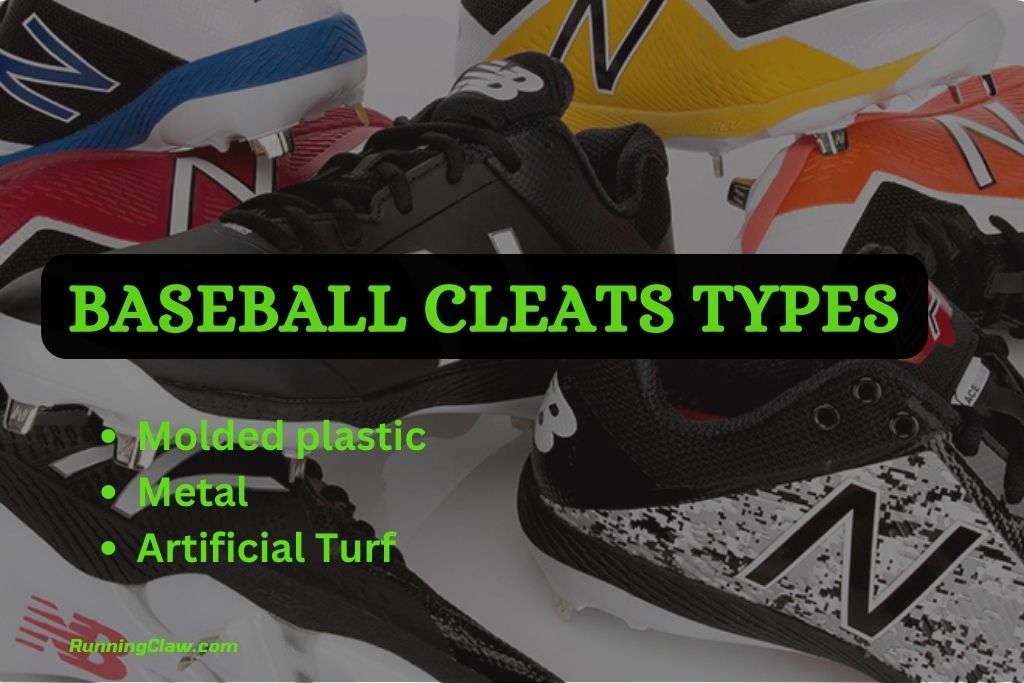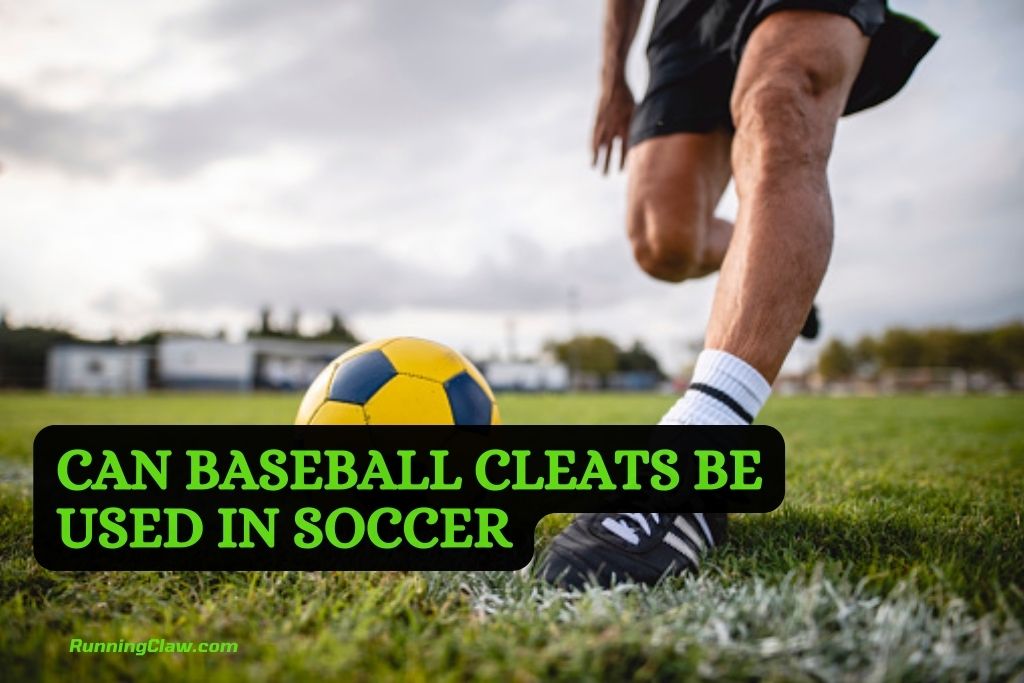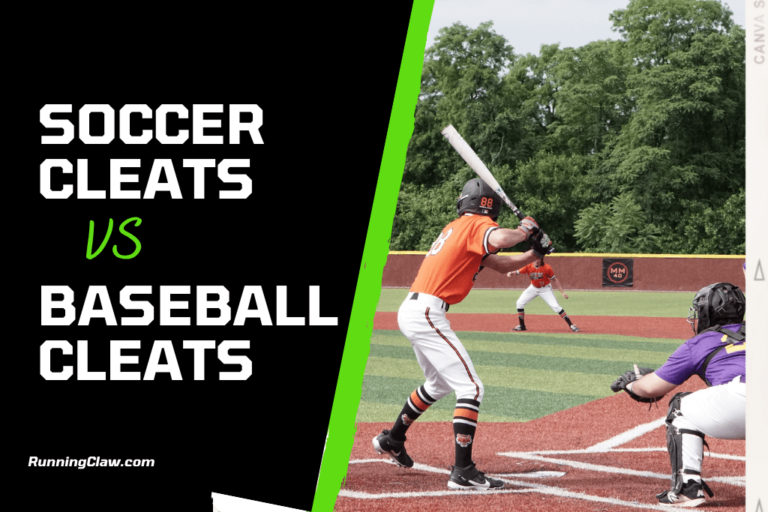Cleats, also called studs, are the things that stick out from the bottom of a shoe. Nowadays, cleats are more common in sports shoes, and the requirements for cleats vary depending on the sport. There are many types of cleats available for different games in the market.
Cleats help the athletes prevent harm on the pitch because it could be slick or muddy. Because they include a lot of running during play, baseball and soccer demand frequent use of cleats.
Now the question arises, what’s the difference between soccer cleats and baseball cleats?
Or
Can soccer cleats be used in baseball and vice versa?
Let’s find it here.
Difference between Soccer and Baseball Cleats
| Aspect | Soccer Cleats | Baseball Cleats |
|---|---|---|
| Playing Surface | Designed for grass pitches (turf) | Suited for mixed grass and dirt (diamond) |
| Traction | Varied stud patterns for quick pivots and bursts | Larger, sturdy spikes for stability and bursts |
| Design | Often low-cut for agility and ball control | Mid- to high-cut for ankle support during slides |
| Upper Material | Focused on lightweight for speed | Durable construction for baseball’s demands |
| Performance Focus | Agility, footwork precision, quick moves | Swift bursts, direction changes, explosive starts |
| Terrain Variety | Less versatile due to specialized studs | Adapts to grass, dirt, and mixed field conditions |
| Ankle Support | Typically less support due to low-cut design | Offers better ankle protection for baseball |
Soccer Cleats
The shoes used to play soccer are called soccer cleats.
What are the Types of Soccer Cleats?

Soccer cleats, for instance, are sorted into four main categories:
- Firm Ground
- Soft Ground
- Turf or Artificial Ground
- Indoor
Material:
Soccer cleats are made of plastic or rubber nubs, which helps the players to protect themselves from injuries. A lightweight material that is more flexible than other materials is used in soccer cleats so that players can get a better feel for the ball. The material at the top of the cleat is made to be more durable so players can endure repeated kicking.
Pattern, Shape, and Studs:
Players need to adapt to various playing surfaces; hence, soccer cleats include studs of variable lengths. These lengths correspond to the numerous positions that can be played on the field. The shape of the cleat is short, round, and blunt.
Sole:
The sole of soccer cleats is constructed in such a way that they bring the player’s feet closer to the surface of the field. It is emphasized by removing the midsole or making the cleats as thin as possible. Additionally, soccer cleats do not cover the ankle to allow for more natural foot movement.
Function:
Soccer cleats are designed with a low center of gravity in mind. The midsole is removed to bring players closer to the ground. As a result of removing the midsole, soccer cleats are slightly lighter than baseball cleats, allowing players to run for 90 minutes or more with the agility and speed they require.
Baseball Cleats:
The shoes which are used for baseball are called Baseball Cleats.
What are the Types of Baseball Cleats?

- Molded plastic
- Metal
- Artificial Turf
Material:
Baseball cleats are made of plastic or rubber at the beginner level, while metal is used to manufacture cleats at a higher or professional level.
Baseball presents a lower risk of injury than other sports because there is less potential for players to contact one another physically.
Because of this, baseball cleats are designed with stability and traction in mind more so than player safety, which is why they include sharp, thin metal spikes.
Additionally, baseball cleats are typically made of plastic or rubber.
Pattern, Shape, and Studs:
A spike is located close to the toe of baseball cleats. This additional spike is designed to be sharp so that players can get a good grip on the ball.
The length of the individual cleats on the shoe is consistent throughout. When compared to soccer cleats, their spikes are much longer and sharper.
Extra cleats on the toes of baseball shoe aid in quick cuts and direction changes on the base paths.
Sole:
These cleats have a thick midsole, and the sole is designed to accommodate that. Baseball cleats contain an ankle support component because the game requires a lot of running and sliding.
Function:
To support pitchers, power hitters, and hard-throwing fielders as they sprint, slide, etc., baseball cleats contain an ankle support function and are made of thicker materials, like leather.
Baseball cleats are heavier because the midsole is incorporated into the sole design, giving players stability to anchor their lower bodies properly.
A lack of ankle support in the ankle design encourages unfettered foot movement.
Related: How to Get Rid of Smell From Cleats
Can baseball cleats be used in soccer?

No, baseball cleats cannot be used in soccer. The referee will never allow you to use baseball cleats on the soccer pitch.
The reason behind this is the extra stud used on the sole of baseball cleats, which can be very dangerous and cause injuries. So, to avoid a severe injury, players are recommended and strictly commanded to wear proper soccer shoes only.
FAQs
Is there a difference between soccer and baseball cleats?
Absolutely, there’s a notable difference between soccer and baseball cleats. Soccer cleats are built for agility and quick moves on grass pitches, with varying stud patterns for pivots and bursts. On the other hand, baseball cleats are designed for stability on mixed grass and dirt surfaces, equipped with larger, sturdier spikes that support rapid direction changes and explosive starts.
What’s the difference between youth soccer and baseball cleats?
The distinction between youth soccer and baseball cleats remains similar to the adult versions. Youth soccer cleats are tailored for agility and precise ball control on grass fields, often mirroring the design of adult soccer cleats. Baseball cleats for youth, just like adults, provide stability for the mixed grass and dirt conditions of the diamond. However, youth cleats might have additional features for comfort and growth.
Are soccer and baseball cleats the same for kids?
Soccer and baseball cleats are not the same for kids. While the basic design principles remain consistent, there are specific youth versions available for both sports. Youth soccer cleats prioritize agility and footwork, whereas youth baseball cleats focus on stability and explosive movements. These youth cleats often come with modifications to ensure comfort, accommodate growing feet, and provide the required performance characteristics for each sport.
Final Words:
In the world of sports, the right footwear can make all the difference, whether you call them cleats, studs, or spikes. This rule applies to baseball, soccer, and beyond. Playing on slick grass or muddy diamonds demands traction and stability, attributes cleats provide for explosive performance.
Ensure your child gets top-notch baseball cleats, granting them an advantage over playing in regular shoes on varied terrains. Remember, breaking in your cleats is key, and proper care guarantees their longevity. So, whether it’s soccer or baseball, the right cleats ensure you’re always on solid ground—literally and metaphorically.
You may also like:


